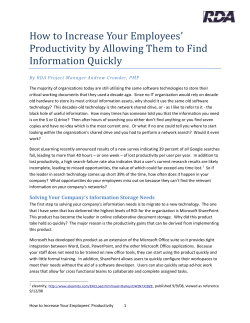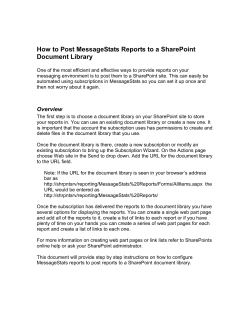
SharePoint
Information Technology Experts, Inc. (ITX) SharePoint April 2009 SharePoint Business Intelligence incorporating Collaboration, Processes, and People Got thousands of business documents scattered all over your network – somewhere on a workstation, laptop, deep in your Server, or in some folder that nobody can find? Need 7 employees to collaborate on a proposal but they’re spread nationwide and version control has gotten out of hand? Think SharePoint • • • • • SharePoint is the fastest-growing product in the history of Microsoft Over 75 million licenses of SharePoint have been sold worldwide SharePoint is listed by Forrester as the #1 portal product SharePoint is positioned as a leader within the Gartner Magic Quadrant for Horizontal Portals products Over 400 case studies have been published on SharePoint What is SharePoint? Share Point is a web-based content management system – or in simpler terms, think of it as an online file cabinet that everybody shares and contributes to. It provides a self-service environment where office workers can take control of information – how it’s organized, who gets access to it, and how it’s displayed. It allows employees to set up a centralized, password-protected space for document sharing. Documents can be stored, downloaded, edited, and then uploaded for continued sharing. SharePoint provides a single, integrated location where employees can efficiently collaborate with team members, find organization resources, search for experts and corporate information, manage content and workflow, and leverage business insight to make better-informed decisions. And here’s the best part….the basic version is free! The free, small-scale version of SharePoint is robust enough to enable most small or medium-sizes businesses to utilize the majority of its functionality. OK, so I may be interested, but what’s the first step? The first activity requires an assessment of your business/network and how you may want to use SharePoint. ITX clients use SharePoint multiple ways – some for internal use only, and some for external client use. For example, Scheduling Consultants, a construction planning & scheduling company, is currently managing schedules for $2.4 billion in construction projects. On average, each project transmits 5-20MB of information per month. The company set up SharePoint for individual projects (called Site Collections) whereby construction companies, architects, foremen, and workers can access it (via the web) and upload schematics, photo’s, and documents throughout the construction process. “SharePoint has helped our internal data management by relieving email size and standardizing the communication of reports that need to be published to clients, says Carmelita Thorndike, Partner & COO, “SharePoint has added value for our clients by 2120 S. College Avenue | Fort Collins, CO 80525 | 970.282.7333 | www.itxfc.com Information Technology Experts, Inc. (ITX) SharePoint April 2009 allowing them to access reports 24x7 from any location, archiving schedule data, and bypassing email which at times can be unreliable especially with large attachments.” How does all the information first get into SharePoint? The flexibility of SharePoint allows for customization to meet your business requirements. It has an infrastructure for uploading documents, but the initial information must be uploaded by someone on your staff. Thus, in assessing your business, you learn the kind of information you need and/or want to share and are motivated to do some housekeeping and clean out those old files that clears up coveted server space. What kind of training is required before I’m comfortable accessing information? Once SharePoint is set up, only minimal training and basic orientation for end-users is necessary because you’re working within a web portal. Other than typing a log-in, working in SharePoint is really no different than being on a regular web page. Learning new things (i.e., managing files via the web) takes time getting used to, so, to utilize SharePoint’s full functionality, ITX recommends you receive a tutorial from someone familiar with your specific SharePoint portal. Do I need to learn new technology to work in SharePoint? If you’re comfortable navigating your way around web sites, conducting searches, clicking links & buttons, exploring, and opening documents, then you’re good to go. Will my network need upgrading for my entire staff to use SharePoint? For an internal SharePoint portal your current network, basic switches, etc. are probably sufficient, (i.e., if your Internet speed is currently adequate, then nothing more should be required). However, if your business wishes to provide an external portal for clients, then you might need to scale bandwidth to as many offsite users you have to meet demand. For example, if there are 50 people nationwide transferring files all day, then network bandwidth will definitely be impacted. Included in the business assessment, ITX also conducts a network review to determine bandwidth needs. What about my Server? ITX recommends you have a dedicated SharePoint server running it – either residing on your own network or trusting a very reliable web hosting company to host it for you. If you have internal IT staff who will administer your SharePoint server, ITX recommends your System Admin be briefed on the particulars of administering SharePoint. Do I need to know Web development to set up SharePoint? SharePoint right out-of-thebox is certainly useable, but isn’t set up for your specific needs. SharePoint comes with various templates that provide a great jump start into customization. They are pre-built, ready-to-use solutions for business applications, portals, and more. However, for a customized portal, ITX recommends a skilled SharePoint web developer/analyst to work with you to customize it to your specific business requirements. It seems complicated. Tell me how a real company uses SharePoint. We previously mentioned how one of our clients uses SharePoint for external collaboration. The 2120 S. College Avenue | Fort Collins, CO 80525 | 970.282.7333 | www.itxfc.com Information Technology Experts, Inc. (ITX) SharePoint April 2009 Group, Inc. Real Estate (TGI), northern Colorado’s leading real estate company, provides an example of internal use (i.e., an Intranet). TGI wasn’t familiar with SharePoint but knew they needed a collaboration tool for use by internal staff – and ITX recommended SharePoint. Kim Allen, TGI’s CFO says “SharePoint has made our Intranet a useful tool that 100% of our staff and realtors use on a daily basis. We are able to store statistics, forms, contracts, etc. for everyone to access when they are on-site or off-site. We use the site for posting information and announcements, shared files, links to frequently used sites, etc. The site is our number one form of communication for our company. It has been very easy to learn and use for everyone.” More than 300 TGI staff can log into their customized SharePoint portal and immediately see 80+ relevant web links, i.e., the MLS. TGI primarily uses SharePoint for announcements, updated roster & contact info, birthdays, logos, documentation, manuals, real estate quarterly statistics, management documents, and their weekly newsletter which saves $80K in paper costs alone. The Community Foundation of Northern Colorado also uses SharePoint as an internal collaboration tool. Roxanne Fry, Chief Operating Officer, embraces everything technology and views SharePoint as a valuable resource for document management/sharing, event management, and organization of resources. “We host a detailed process and procedures manual on SharePoint, which provides a central point of reference for staff and interns. In addition, through customized permission settings, we’ve been able to grant secure access to key documents and information to an outsourced event planner”, says Roxanne. What are the benefits of using SharePoint? 1. Create and share a complete view of your business 2. Simplify company-wide access to information across disparate systems 3. Find and make the most of your organization’s intellectual capital 4. Accelerate shared business processes across organizational boundaries 5. Give users the ability to organize and collaboratively edit their documents 6. Bring projects to completion at a much quicker rate 7. Improve team productivity with easy-to-use collaborative tools 8. Manage documents and help ensure integrity of content 9. Repurpose content to gain increased business value 10. Speed adoption by using familiar interfaces and tools 11. Reduce the complexity of securing business information 12. Enable people to make better-informed decisions by presenting business-critical information in one central location 13. Take file sharing to a new level with robust storage capabilities 14. Provide a cost-effective foundation for building Web-based applications I’m a visual learner. Please show me SharePoint functionality in a graphic format. 2120 S. College Avenue | Fort Collins, CO 80525 | 970.282.7333 | www.itxfc.com Information Technology Experts, Inc. (ITX) SharePoint April 2009 Content Management: Over the last several years, organizations have created a huge volume of unstructured content that includes documents, e-mail messages, videos, instant messages, web pages, and more. This content often exists in an unmanageable state of chaos that prevents an organization from properly using these valuable assets for better knowledge sharing, improved customer communications, and increased process efficiency. Collaboration: SharePoint helps your organization accomplish more by providing a platform conducive to people-driven processes that allows for sharing information and working together within teams and communities. Business Process: SharePoint provides built-in workflow templates to automate approval, review, and archiving processes. With SharePoint you can also create, maintain, and analyze custom workflows, which enables you to streamline your collaborative processes. Portal sites connect your people to critical business information, expertise, and applications. SharePoint is a world class Enterprise Portal platform that makes it easy to build and maintain portal sites for every aspect of your business. Search: SharePoint is the Microsoft enterprise search solution for organizations that want to increase productivity and reduce information overload by providing their employees, partners, and customers the ability to find relevant content in a wide range of repositories and formats. With actionable search results that respect security permissions, SharePoint lets users go beyond documents and across repositories to unlock information, find people, and locate expertise within the company. Business Intelligence with SharePoint provides an infrastructure that makes it easy for decision-makers to access information anytime, anywhere. People can get up-to-date information wherever they work, collaborate, and make decisions; whether it's on the desktop or over the Web. 2120 S. College Avenue | Fort Collins, CO 80525 | 970.282.7333 | www.itxfc.com Information Technology Experts, Inc. (ITX) SharePoint April 2009 Glossary of Terms SharePoint: Microsoft's content management system that allows groups to set up a centralized, password-protected space for document sharing. Documents can be stored, downloaded, edited, and then uploaded for continued sharing. Groupware: Collaborative software designed to help people involved in a common task achieve their goals; the basis for computer supported cooperative work. Software systems such as e-mail, calendaring, text chat, and wiki belong in this category. It has been suggested that Metcalfe's law — the more people who use something, the more valuable it becomes — applies to such software. A content management system (CMS) is a computer system used to track and store electronic documents and/or images of paper documents. CMS users can create, edit, manage, search, and publish various kinds of digital media and electronic text. CMS’s are frequently used for storing, controlling, versioning, and publishing industry-specific documentation such as news articles, technical manuals, sales guides, and marketing materials. The content managed may include computer files, images, audio files, video files, electronic documents, and Web content. Wiki is a Hawaiian word for fast. A wiki is a page or collection of Web pages designed to enable anyone who accesses it to contribute or modify content using a simplified markup language. Wikis are often used to create collaborative websites and to power community websites. The collaborative encyclopedia, Wikipedia, is one of the best-known wikis. Wikis are used in business to provide intranet and Knowledge Management systems. A blog (a contraction of the term weblog) is a website, usually maintained by an individual with regular entries of commentary, descriptions of events, or other material such as graphics or video. Entries are commonly displayed in reverse-chronological order. A web portal presents information from diverse sources in a unified way. Apart from the search engine standard, web portals offer other services such as e-mail, news, stock prices, infotainment, and other features. Portals provide a way for companies to provide a consistent look and feel with access control and procedures for multiple applications, which otherwise would have been different entities altogether. An example of a web portal is MSN, Yahoo!, and Google. 2120 S. College Avenue | Fort Collins, CO 80525 | 970.282.7333 | www.itxfc.com
© Copyright 2025





















